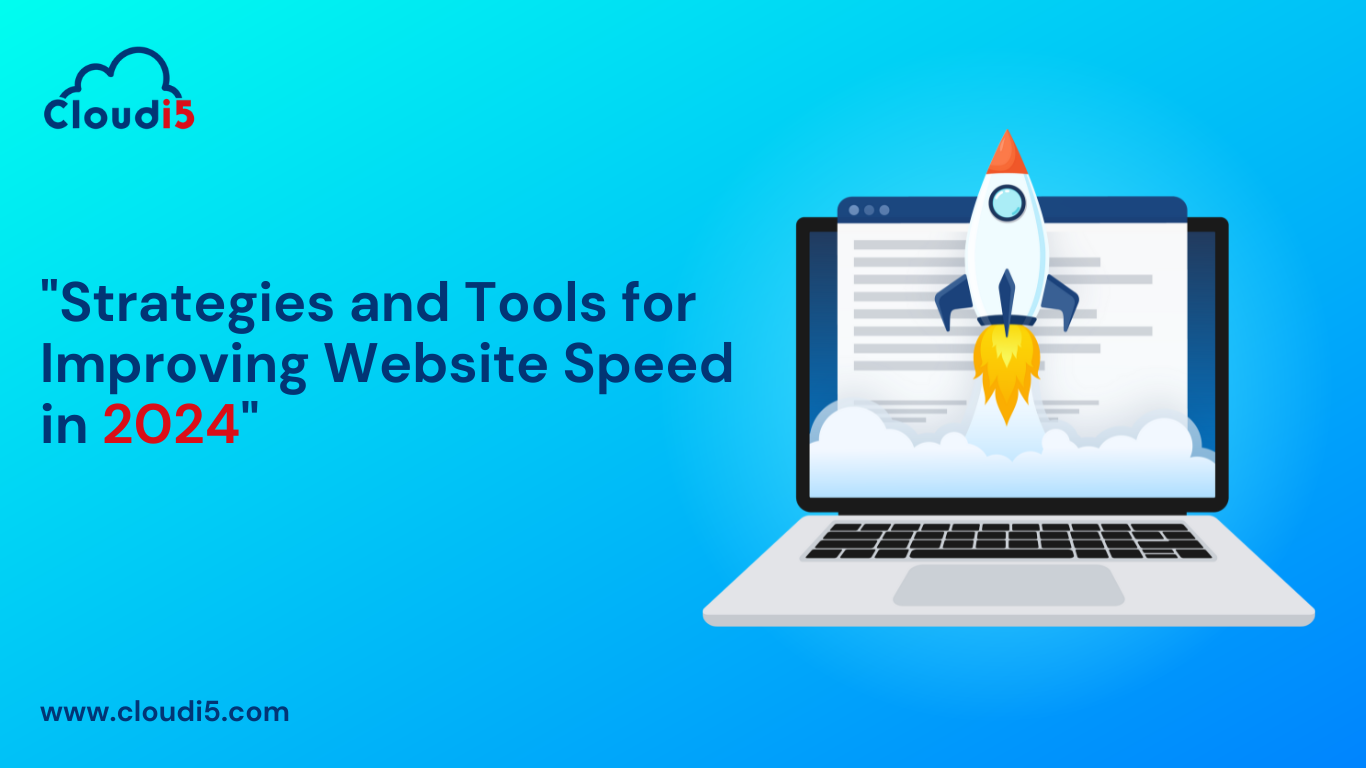
Strategies And Tools For Improving Website Speed In 2024
The speed of your website is more important than ever in 2024 in the fast-paced world of internet browsing when a single second can make all the difference in user engagement. Ensuring quick and flawless loading experiences has become essential to success in the digital world, as people's attention spans are getting shorter and their patience is running thin. But worry not—a plethora of creative tactics and cutting-edge resources have surfaced in this fast-paced period to catapult your website to the front of the digital competition.
Come along with us as we navigate the always-changing world of web optimization, armed with the most recent knowledge and tactics to catapult your online presence into the digital dominance lane.
Understanding the importance of website speed:
In terms of website speed optimization in 2024, combining marketing SEO approaches with cutting-edge solutions is critical for increasing user engagement and search engine rankings. Users of today expect immediate access to information. Understanding how to improve website speed is critical for providing a flawless surfing experience to consumers, which may be accomplished by optimizing graphics, reducing HTTP requests, and utilizing caching strategies.
Websites that load slowly cause users to become frustrated and give up. Speedier websites generate more organic traffic since they rank better on search engine results pages. Fast-loading websites are critical for retaining mobile customers in light of the explosive growth in mobile usage. Website speed directly affects income production since faster websites convert at higher rates. Website speed distinguishes brands by indicating dependability and professionalism. Website performance is given top priority by Google's Core Web Vitals, which also affects user experience and search rankings.
User experience, SEO rankings, and conversion rates are all strongly impacted by website speed. Quick loading times increase engagement, lower bounce rates, and improve user happiness. Fast-loading websites are given preference by search engines, which increases their exposure and organic traffic through higher SEO ranks.
Furthermore, speedier websites typically have greater conversion rates because they provide easier user experiences and foster visitor confidence, which boosts conversions and promotes business success. In order to maximize user pleasure, search exposure, and conversion chances in the digital realm, website performance optimization is crucial.
Performance Optimization Strategies:
Increasing the speed of a website depends on a number of important tactics designed to improve user experience and performance. Above all, it is critical to optimize multimedia assets and photos by reducing file sizes without sacrificing quality.
Caching Mechanism:
Caching is the process of keeping duplicates of website assets (such as CSS, JavaScript, HTML files, and photos) on a user's device or a server, acting as a middleman.
Loading times are greatly decreased when a user sees a cached webpage since the browser may obtain these resources locally rather than having to fetch them from the server again.
Minification:
The technique of eliminating extraneous characters from code—like whitespace, comments, and line breaks—without compromising its usefulness is known as minification.
JavaScript, HTML, and CSS files can be made smaller by minifying them, which speeds up browser parsing and download times.
Automatic code minification in development is a typical use case for tools such as UglifyJS for JavaScript and CSSNano for CSS.
Compression:
Website resources are made smaller through compression, which encrypts them in a more effective format before sending.
Popular compression techniques like Gzip and Brotli are used to reduce the size of HTML, CSS, JavaScript, and other server files.
The server sends the compressed version of a resource that a browser requests and the browser decompresses it before producing the page.
Image Optimization:
Usually, a large percentage of the file size of a webpage is made up of images. Image optimization is the process of lowering an image's file size without compromising quality.
Techniques include:
- Employing image compression programs like JPEGoptim, PNGOUT, or ImageOptim.
- Shrinking images to the proper proportions.
- Selecting the appropriate file format (e.g., JPEG for photos, PNG for graphics with transparency).
Lazy Loading:
When non-essential resources (such as pictures or videos) enter the user's viewport, lazy loading waits until that point to load them.
By loading only the most important content initially, this strategy speeds up the user's ability to interact with the page and minimizes initial page load times.
Lazy loading can be implemented with libraries like LazyLoad.js or native browser features like HTML5's "loading" element.
Leveraging advanced tools for speed optimization:
Enhancing user experience and search engine rankings requires speed optimization. Using cutting-edge technologies can be helpful in this attempt. In 2024, incorporating advanced SEO optimization technologies into speed enhancement tactics can help boost website performance, ensuring both lightning-fast load speeds and increased search engine visibility.
You can use the following sophisticated tools and methods for performance optimization:
Google PageSpeed Insights: This tool examines a website's content and offers recommendations for speeding it up. It provides you with insights into real-world performance measures by providing both lab and field data.
WebPageTest: This tool lets you use actual browsers to evaluate your website's speed from numerous places across the globe. To identify performance problems, it offers numerous metrics, filmstrip view, and intricate waterfall charts.
Lighthouse: Lighthouse provides audits for performance, accessibility, SEO services, and other areas and is integrated into Chrome DevTools. It offers doable suggestions for enhancing user experience and website speed.
GTmetrix: GTmetrix provides a thorough speed analysis of your website as well as useful suggestions. It offers thorough performance reports in addition to PageSpeed and YSlow ratings.
Pingdom: Pingdom delivers performance insights and historical data to measure improvements over time. It offers website speed testing from many locations.
Webpack: A module bundler for JavaScript applications is called Webpack. It can be used to minify CSS and JavaScript files to speed up load times, optimize pictures, and bundle JavaScript scripts for better performance.
Caching: By supplying content that has already been cached rather than having it generated dynamically for each request, server-side and client-side caching can dramatically lower load times.
Tools for Image Optimization: Images frequently cause sluggish page loads. Utilizing programs like Adobe Photoshop, Kraken.io, or ImageOptim, one can optimize photographs by decreasing their file size without sacrificing quality.
Server-side Performance Optimization:
- Use methods like gzip compression.
- Reduce server response times.
- Optimize database queries to make sure your server is running as efficiently as possible.
Using these advanced tools and approaches, you can efficiently optimize your website's speed, giving users a faster and more delightful browsing experience while enhancing your search engine rankings.
Mobile Optimization for Enhanced Speed:
Mobile optimization is critical for delivering a speedy and consistent user experience on smartphones and tablets. Here are several ways specifically designed to increase speed on mobile devices:
Responsive Design: Make sure your website is responsive and can adjust to different screen sizes and resolutions. In CSS, use media queries to change the layout and content for different devices.
Accelerated Mobile Pages (AMP): Use AMP to build lightweight, fast-loading versions of your web pages that are optimized for mobile devices. AMP limits the use of JavaScript and prioritizes vital material for faster rendering.
Optimize photos: Compress and resize photos for mobile devices to minimize file size and speed up loading. Use responsive image approaches and explore adopting next-generation picture formats like WebP to improve compression.
Reduce the number of HTTP requests by merging CSS and JavaScript files, as well as utilizing inline CSS and other essential CSS approaches. Fewer queries lead to speedier load times, particularly on slower mobile networks.
Optimize Fonts: To reduce the need for additional font downloads, use web-safe or system fonts instead. To reduce file size and speed up rendering, limit the amount of font styles and weights used.
Implementing these mobile optimization tactics will greatly improve your website's speed and performance on mobile devices, resulting in a better user experience and higher mobile search ranks.
Conclusion:
To summarize, the landscape of website speed optimization in 2024 is characterized by a variety of innovative tactics and tools targeted at providing great user experiences and increasing online presence. Website owners can improve loading times and responsiveness across all devices, including mobile platforms, by using tools such as Google PageSpeed Insights, WebPageTest, and Lighthouse, as well as sophisticated strategies like lazy loading, HTTP/2 adoption, and server-side optimizations.
Trusted By












Leave Comments